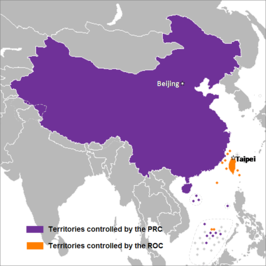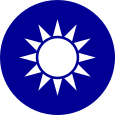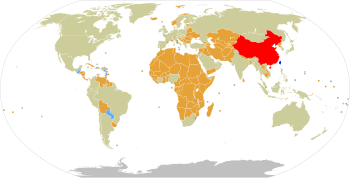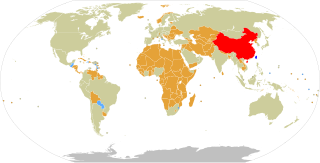
Foreign relations of the Republic of China (ROC), informally known as Taiwan, are accomplished by efforts of the Ministry of Foreign Affairs of the Republic of China, a cabinet-level ministry of the Government of the Republic of China. It currently has formal diplomatic relations with 11 of the 193 United Nations member states and with the Holy See, which governs the Vatican City State, as of 4 April 2024. In addition to these relations, the ROC also maintains unofficial relations with 59 UN member states, one self-declared state (Somaliland), three territories (Guam, Hong Kong, and Macao), and the European Union via its representative offices and consulates. In 2021, the Government of the Republic of China had the 33rd largest diplomatic network in the world with 110 offices.
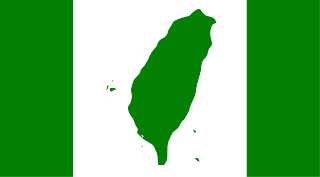
The Taiwan independence movement is a political movement which advocates the formal declaration of an independent and sovereign Taiwanese state, as opposed to Chinese unification or the status quo in Cross-Strait relations.

"Mainland China", also referred to as "the Chinese mainland", is a geopolitical term defined as the territory under direct administration of the People's Republic of China (PRC) in the aftermath of the Chinese Civil War. In addition to the geographical mainland, the geopolitical sense of the term includes islands such as Hainan, Chongming, and Zhoushan. By convention, territories outside of mainland China include:
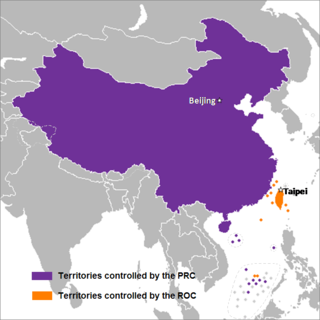
Chinese unification, also known as Cross-Strait unification or Chinese reunification, is the potential unification of territories currently controlled, or claimed, by the People's Republic of China and the Republic of China ("Taiwan") under one political entity, possibly the formation of a political union between the two republics. Together with full Taiwan independence, unification is one of the main proposals to address questions on the political status of Taiwan, which is a central focus of Cross-Strait relations.
The controversy surrounding the political status of Taiwan or the Taiwan issue is an ongoing dispute on the political status of Taiwan, currently controlled by the Republic of China (ROC). This dispute arose in the mid-twentieth century.
The term One China may refer, in alphabetical order, to one of the following:
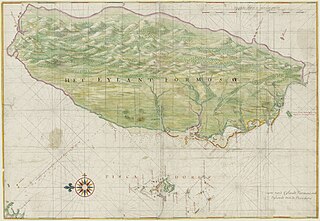
As a result of the surrender and occupation of Japan at the end of World War II, the islands of Taiwan and Penghu were placed under the governance of the Republic of China (ROC), ruled by the Kuomintang (KMT), on 25 October 1945. Following the February 28 massacre in 1947, martial law was declared in 1949 by the Governor of Taiwan, Chen Cheng, and the ROC Ministry of National Defense. Following the end of the Chinese Civil War in 1949, the ROC government retreated from the mainland as the Chinese Communist Party (CCP) proclaimed the establishment of the People's Republic of China. The KMT retreated to Taiwan and declared Taipei the temporary capital of the ROC. For many years, the ROC and PRC each continued to claim in the diplomatic arena to be the sole legitimate government of "China". In 1971, the United Nations expelled the ROC and replaced it with the PRC.

The Anti-Secession Law is a law of the People's Republic of China, passed by the 3rd Session of the 10th National People's Congress. It was ratified on March 14, 2005, and went into effect immediately. President Hu Jintao promulgated the law with Presidential Decree No. 34. Although the law, at ten articles, is relatively short, Article 8 formalized the long-standing policy of the PRC to use military means against Taiwan independence in the event peaceful means become otherwise impossible. The law does not explicitly equate "China" with the People's Republic of China.
The 1992 Consensus is a political term referring to the alleged outcome of a meeting in 1992 between the semiofficial representatives of the Chinese Communist Party (CCP)-led People's Republic of China (PRC) of mainland China, and the Kuomintang (KMT)-led Republic of China (ROC) of Taiwan. They are often credited as creating a diplomatic basis for semi-official cross-strait exchanges which began in the early 1990s and is a precondition set by the PRC for engaging in cross-strait dialogue.

Cross-Strait relations are the relations between China and Taiwan.

The free area of the Republic of China, also known as the "Taiwan Area of the Republic of China", the "Tai-Min Area " or simply the "Taiwan Area", is a term used by the government of the Republic of China (Taiwan) to refer to the territories under its actual control. It is also used as a legal term written in the Additional articles of the ROC constitution and Cross-Strait Act.

"Taiwan, China", "Taiwan, Province of China", and "Taipei, China" are controversial political terms that claim Taiwan and its associated territories as a province or territory of the People's Republic of China.
An exclusive mandate is a government's assertion of its legitimate authority over a certain territory, part of which another government controls with stable, de facto sovereignty. It is also known as a claim to sole representation or an exclusive authority claim. The concept was particularly important during the Cold War period when a number of states were divided on ideological grounds.

Taiwan Province, PRC refers to a notional administrative division claimed by the People's Republic of China. The PRC constitution asserts Taiwan as part of its territories although the PRC has never controlled Taiwan since the PRC's establishment in 1949. The territory of the claimed province, including the entire island of Taiwan, is in actuality administered by the Republic of China (ROC) but is not coextensive with the smaller Taiwan Province of the ROC.

South Korean–Taiwan relations

Relations between the Holy See and the Republic of China were established on a non-diplomatic level in 1922 and at a diplomatic level in 1942. The Holy See, under the One-China policy, recognizes the Republic of China as the representative of China.
Special non-state-to-state relations is a term used by Ma Ying-jeou, the former President of the Republic of China, to describe the nature of relations between the Taiwan Area and the Mainland China Area. President Ma has used the term at least once, although to describe the term as a concept or policy would be premature, especially as it describes those relations loosely in terms of what they are not.

Singapore–Taiwan relations are the international relations between Singapore and Taiwan. Taiwan has a representative office in Singapore. Singapore operates the Singapore Trade Office in Taipei in Taiwan, both of whom are members of the World Trade Organization (WTO). The Presidential Envoy of ROC and Prime Minister of Singapore regularly meet, in the form similar to private state-to-state gesture diplomacy at APEC.
The administrative divisions of China between 1912 and 1949 were established under the regime of the Republic of China government.

Nauru–Taiwan relations are relations between the Republic of Nauru and Taiwan, officially the Republic of China (ROC). Official diplomatic relations were first established in 1980. Relations were first severed in 2003, when Nauru opted to recognize the People's Republic of China. Formal bilateral relations with Nauru were reestablished in 2005, and maintained until 2024.
